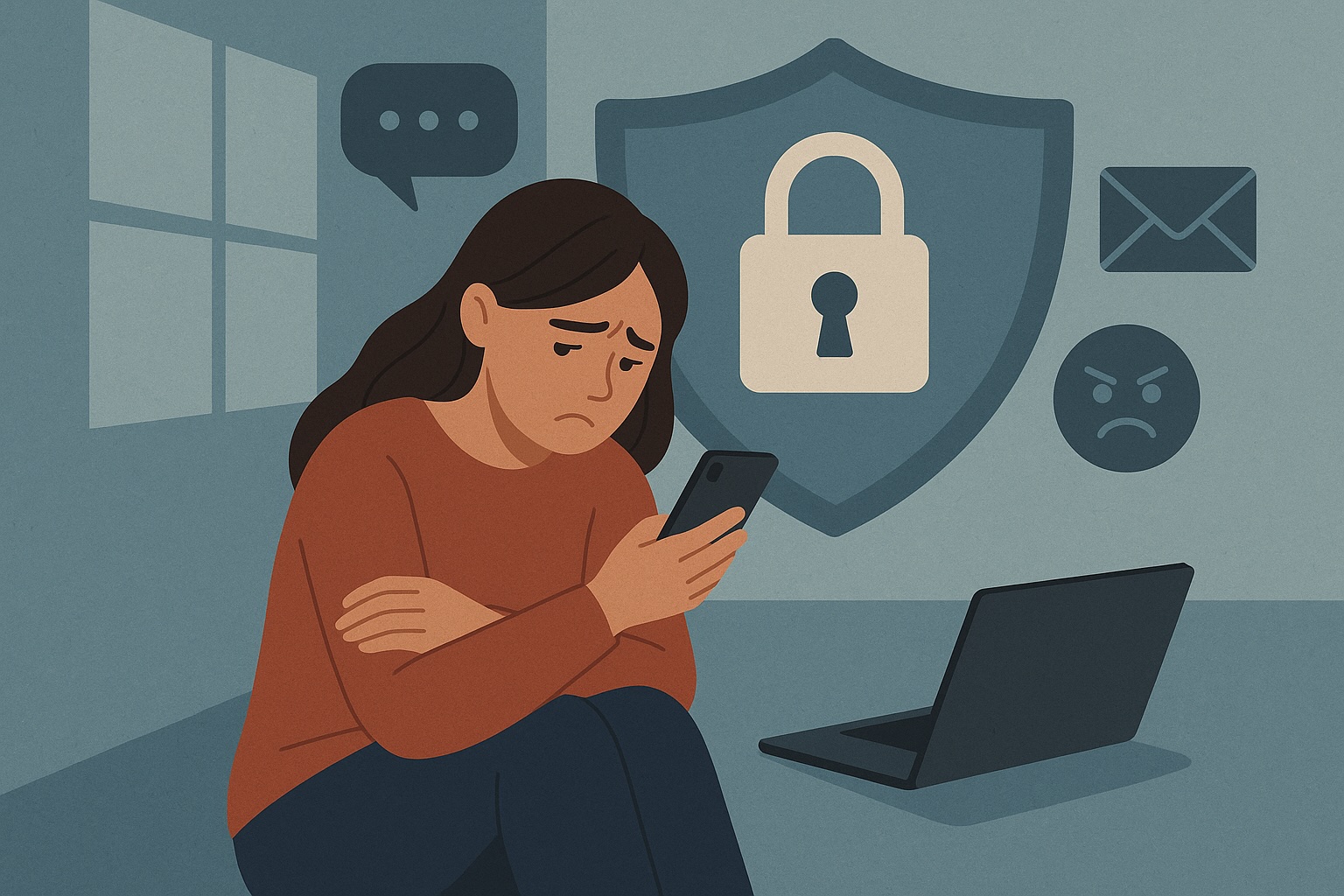Technology and Digital Abuse: How to Protect Yourself in Ontario
Digital abuse is real—and rising. Learn how to protect your devices, online accounts, and personal privacy from a controlling or abusive partner in Ontario.

Technology can be a tool for safety—but also a weapon in the hands of an abusive partner. **Digital abuse** includes monitoring your phone, tracking your location, hacking your accounts, or controlling how you use technology.
This post explains how to recognize digital abuse, protect your privacy, and take back control of your tech life in Ontario.
***
### 🚨 What Is Digital or Tech-Enabled Abuse?
Digital abuse can include:
* Reading your messages, call logs, or emails without consent
* Installing **spyware or GPS tracking** on your phone or car
* Forcing you to share passwords or unlock devices
* Impersonating you online
* Using smart home devices (like cameras or doorbells) to monitor your movements
* Sending threats or harassment via text, social media, or email
* Using revenge porn or threats to expose private information
* Controlling access to your phone, internet, or social media
***
### 🛡️ How to Protect Yourself
#### 🔐 Secure Your Devices
* **Change all passwords**—use unique ones for email, banking, and social media
* Set up **2-step verification** where possible
* Scan devices for **spyware or unknown apps**
* Perform a **factory reset** if you suspect tracking
* Avoid using shared devices if you're in danger
#### 📱 Protect Your Location
* **Turn off location sharing** in all apps and settings
* Disable GPS when not needed
* Check for unknown tracking devices (AirTags, Bluetooth trackers)
* Don’t tag real-time locations on social media
#### 🧠 Control What You Share
* Log out of shared email or cloud accounts
* Block access to shared calendars, photo albums, or smart home devices
* Ask trusted friends not to post your whereabouts online
* Use **“incognito” mode** or public computers for sensitive research (like shelters or legal aid)
***
### 🛠️ Tools That Can Help
* **Incognito mode** for private browsing
* **Signal or WhatsApp** for encrypted messages
* **App permissions settings** to block camera/mic access
* **Facebook Privacy Checkup** to lock down visibility
* **Canary apps** or panic buttons if you’re being stalked
> Always consider your abuser's tech skill level—some abuse is invisible.
***
### 👩💼 Legal Protections for Digital Abuse in Ontario
* **Harassment, threats, and stalking** are crimes under the Criminal Code
* You can seek a **restraining order or peace bond** even for tech-based threats
* Judges may ban an abuser from contacting you via **text, email, or social media**
* **Digital evidence** (screenshots, call logs, AirTag records) is admissible in court
***
### 📌 Summary: Staying Safe from Digital Abuse
* ✅ Change passwords and use 2FA to protect access
* ✅ Turn off location sharing and check for trackers
* ✅ Don’t store private info on shared devices
* ✅ Log evidence of harassment (safely and securely)
* ✅ Reach out to legal aid or DV services for help
***
### 📞 Where to Get Help
* **Assaulted Women’s Helpline (24/7):** 1-866-863-0511
* **Cybertip.ca** – Report online harassment or stalking
* **Luke’s Place** – Legal help for women experiencing tech-enabled abuse
* **Ontario Provincial Police (OPP)** – Non-emergency line for stalking or tech threats
* **211 Ontario** – Find digital safety workshops and survivor tech supports
***
### Frequently Asked Questions (FAQs)
#### 1. Is it illegal for my partner to post my private photos online in Ontario?
Yes. Sharing an intimate image of someone without their consent is a specific criminal offence in Canada. If this happens to you, you should report it to the police immediately.
#### 2. How can I find out if there is spyware on my phone?
Signs of spyware can include your battery draining unusually fast, your phone being slow or hot, or seeing unfamiliar apps. If you suspect spyware has been installed, the safest option is often to back up your essential data (like photos and contacts) and then perform a factory reset of the device.
#### 3. What is the most important online account to secure first?
Your primary email account is the most critical account to secure. It often acts as the key to all your other accounts through the "forgot password" function. Change the password and enable two-factor authentication (2FA) on your email first.
#### 4. I'm afraid to change my passwords because my abuser will get angry. What should I do?
This is a common and valid fear, as a sudden change can alert the abuser and escalate the danger. This is why it's essential to do your safety planning on a device the abuser doesn't have access to. Contact the Assaulted Women's Helpline (1-866-863-0511) to create a safety plan *before* you make any changes to your devices.
#### 5. Is cyberstalking a crime in Ontario?
Yes. While "cyberstalking" isn't a specific term in the *Criminal Code*, the behaviour falls under the offence of Criminal Harassment. If someone is repeatedly contacting you, following you online, and making you fear for your safety, you can report it to the police.
#### 6. Where can I get help creating a technology safety plan?
Organizations like Tech Safety Canada (run by Women's Shelters Canada) have excellent online resources and toolkits. You can also get direct, confidential help with safety planning from your local women's shelter or by calling a 24/7 crisis line.
